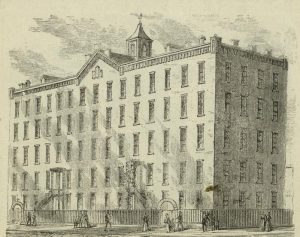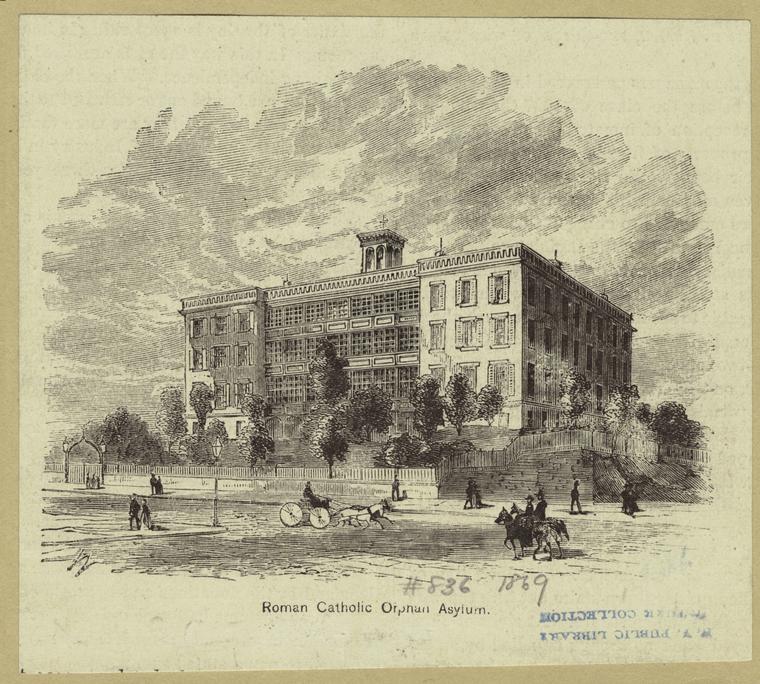
Image source: The New York Public Library.
St. Joseph’s Orphanage, New York
The School Sisters of Notre Dame operated St. Joseph’s Orphanage, located in Yorkville, a neighborhood of Manhattan’s Upper East Side from 1859 until it closed in 1918. The sisters who worked at the orphanage went to great lengths to provide a clean, safe home for the children who lived there. Unfortunately, some things were beyond their control.
Fire
Fires were common in 19th century America for many reasons, including an abundance of wooden buildings, the use of lanterns and candles and a lack of safety plans. The chronicle for St. Joseph’s lists many fires, great and small, that occurred throughout the years. What follows are excerpts from the chronicles that describe some of the fires that occurred.
1861: The orphanage’s first experience with fire occurred in February 1861. In the middle of the night a fire was discovered and the children were awakened from a deep sleep by the house bell. “Anxiety and fear filled most of them and took their presence of mind, so that a terrible accident happened.” An 11-year old boy fell from the fourth floor and was severely injured. A doctor was called, but the boy eventually died from his injuries. “Due to this terrible accident and painful experience, a wire fencing was installed between each floor of the staircase to prevent such an experience in the future. Although the damage through the fire by itself was unimportant, yet we had to mourn a human being, certainly a much great misfortune than any financial loss…”
1868: “At the beginning of January we were again threatened by fire, namely by the carelessness or inexperience of an older girl; who wanted to turn off the gas in the morning. But as the gas pipe was located higher than she could reach, she slipped and held on to the gas pipe which ripped off the wall. She did not report it. When the gas was turned on in the evening a strong odor of the escaping gas was noticed. When finally, Sister M. Paula Chateau held a candle toward the ceiling where the gas pipe was loose, the gas ignited. The sisters just finished night prayers when several girls came running down the stairs calling out: Sister our house is burning! The sisters hurried to the gas meter and turned off the gas, and extinguished the fire at the same time. Fortunately, no further mishap ensued!”
1887: “…On July 16, 1887, at 3 a.m. on the lowest floor of the boys’ side fire broke out. The whole building with all the sleeping residents would have become victims of the flames if the night-watchman had not awakened us on time. By the presence of mind of the sisters who had all children assembled to march off, a panic was forestalled. Also, our older boys proved themselves heroic, which astounded all. Without awaiting a command to wait, they carried the little boys on their shoulders down the fire escapes until all were safe. Even before the fire department arrived all children were safe. In the meantime, the conflagration made rapid progress along the corridors up to the room. The house was so filled with smoke that no exit could be found…Four of our older orphan boys, Philip Richter, John Hanly, George Bieder, and William Link, also the night-watchman, received each a silver medal as token of their heroic courage during the fire.”
Note: Although all the children made it out safely, the writer goes on to say that an 8-year old boy ran back into the house to get dressed. He was overcome by the smoke and was found by the firemen. He died that evening.
1893: “On the same day [Aug. 18] before 9 p.m. as the sisters were saying night prayers in the garden suddenly fire broke out in the basement of the infirmary. Filled with horror, Sr. M. Salomea Fritz remembered that in that room a large barrel of sulphur was kept to fumigate from time to time the infirmary rooms. With great calm and presence of mind she hastened to roll this dangerous barrel outside which fortunately she managed to do. With the help of God and our combined strength we removed the danger completely before the fire engines arrived here with great noise and abundant accompaniment of the screaming street urchins within a few minutes. Industriously, these eager men looking for the fire with their lanterns held high, asked us all kinds of questions which we all answered to their satisfaction…In the meantime our 700 children slept the sleep of innocence, not knowing of the danger in which they were, not even noticing the noise which fire-engines usually accompanied…The fire was caused by the carelessness of a few older boys who had oil-soaked rags used by the painters rolled together and hidden in a corner of the basement. Fortunately, the damage was not much and amounted to about 8 or 10 dollars.”
Disease
Illnesses, such as measles, diphtheria, smallpox and tuberculosis, were common in 19th century and early 20th century America. Prior to the advent of antibiotics, vaccines and even an accurate understanding of how disease spread, these types of illness spread quickly and were often deadly.

Image source: The New York Public Library.
St. Joseph’s chronicles are filled with entries describing various illnesses that swept through the orphanage. The sisters and the orphanage doctors did their best to care for the sick children, but their efforts were not always enough to save a child’s life.
1859: “In the following month of April the number of children already increased by several boys from Randall’s Island who were afflicted with very sore eyes; as this malady occurred in epidemics, our sisters also were not spared, who had to suffer in more than one way. Day and night, they had to care for the poor little ones. With God’s help, in time the illness was eased at least in part, and will be conquered soon altogether. In August we received 13 little ones who could not yet walk. However, most of these little ones died of scarlet fever; although our Dr. J. Feulage, our first doctor tried everything to conquer this dangerous and contagious sickness. May these innocent first victims of our institution obtain for us the blessing of heaven for us, that our dear Lord may protect us from all evil in the future…”
1880: “During the first months of this year 39 children had the measles and 5 had pneumonia.”
1882: “During the month of January all of our children were vaccinated to prevent them from contracting the smallpox which were spreading in the city.”
1884: “At the end of July three children were brought to us, one of whom promptly got the measles on the following day and scarlet fever. The malady spread quickly before anything could be done to stop the epidemic. 55 children caught the illness, 16 of them died. During the month of August the sisters had no rest, day or night. They sacrificed themselves with great love for the children, until toward the end of Sept. the illness was conquered.”
1893: “In the course of this winter a very malicious epidemic of eye trouble, called Ophthalmia perulenta, broke out, and as Doctor McNicholas, just recently engaged for our children, did not check in regularly, the malice spread with great rapidity in a few days to 150 children. A similar terrible epidemic had not yet been recorded in the chronicle of this house. In place of the physician named above, Doctor Cole Bradly, who has recently completed his studies in England and has a few days ago arrived in New York, was recommended. As he has concentrated on ophthalmology he was excellent in choosing ways and means to check this troublesome disease whereby he had to spent several hours with the patients daily. The instructions had to be discontinued for several weeks as the classrooms had to be used as infirmaries and the sisters were involved in the care of the sick day and night by applying hot or cold compresses. With truly self-sacrificing love the sisters devoted themselves to the care of these little ones, not sparing themselves, although some of them also were afflicted with eye trouble. For weeks, the epidemic raged until finally after Christmas this malice was somewhat checked. May our dear Lord in future spare us from similar tests…”
1896: “As contagious diseases, diphtheria and scarlet fever, were spreading quickly in the city they also invaded our orphanage. We did not have to suffer much as the conscientious and zealous physician Dr. Cole did his best to check the invasion; yet it was difficult for us to assuage the relatives of the children, as for a time of three months they were not allowed to see the children or talk to them.”
1912: “…Shortly after, on Feb. 5, namely, an epidemic broke out, this time the measles, for about 100 children. On Feb. 16, a little boy died of diphtheria. His little brother was sent to Willard Parker Hospital. After two days, this child also died of diphtheria. These 2 children had a heavy cold when they came to our house. We gave these children all the possible care to save them, but God had other plans. Their father was inconsolable; we could not calm him down.”
Closing of St. Joseph’s
St. Joseph’s Orphanage closed in 1918, but the processing of closing began several years earlier. The last chronicle entry nicely sums up life at St. Joseph’s.
1918: “During the month 19 children were taken to relatives. Now not one child was left in the house. Everything was desolate. For 60 years the sisters sacrificed their strength for the benefit of the little ones. They, too, had to leave the home they had learned to love, had to look for another place to stay….In closing we wish to mention that 8,345 children had found a house in our orphanage. Certainly, we owe God a debt of gratitude. His fatherly eye watched over us day and night and never has he withdrawn his grace and blessing. Also, our dear Mother of God and St. Joseph have lovingly provided for us. The Poor Souls, also we should remember all our lives, because they, too, by their intercession for us with God have obtained for us many graces and blessings.”
